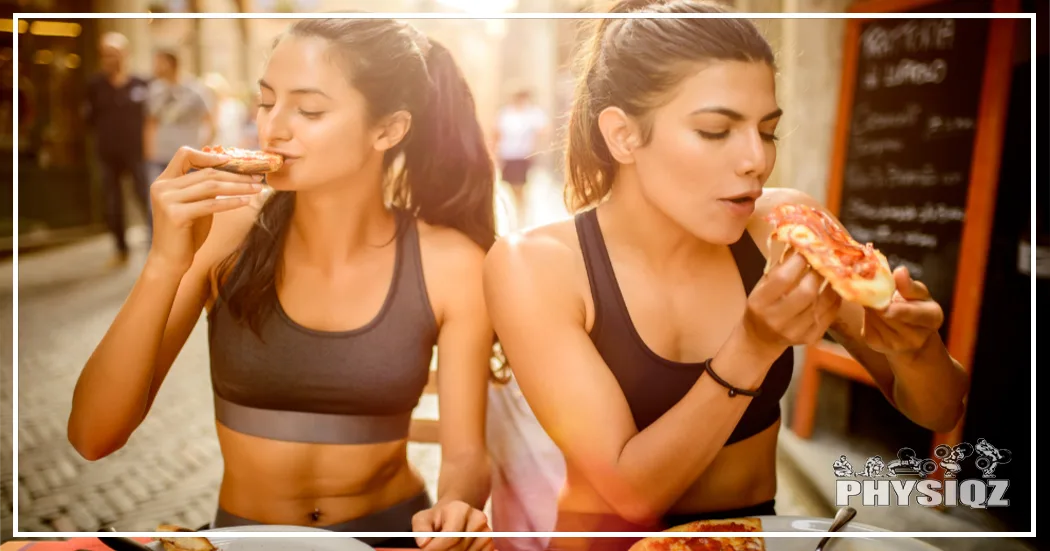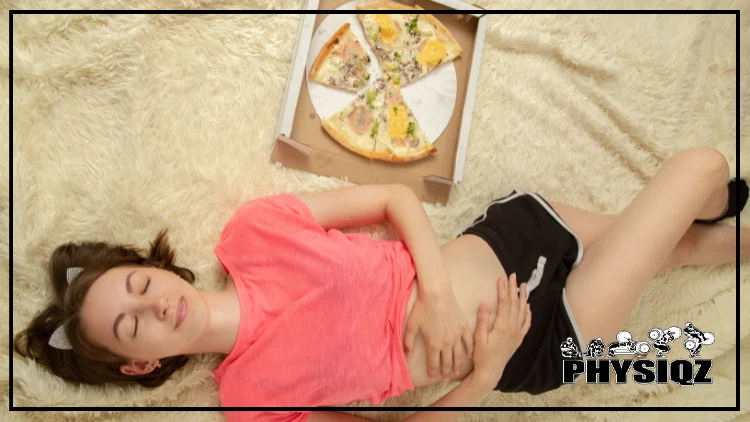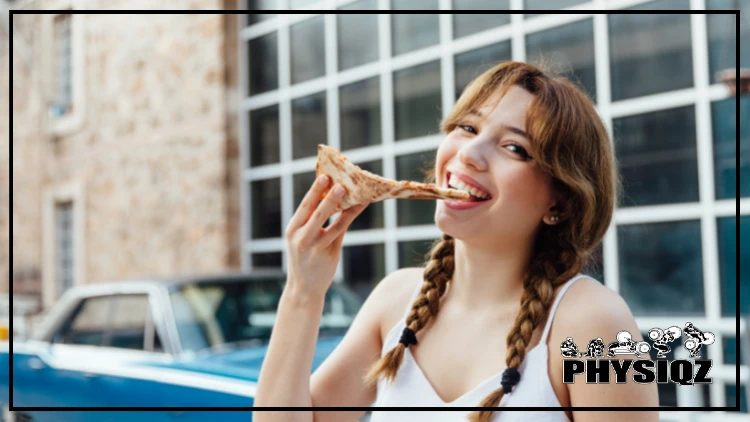
For pizza enthusiasts aiming to shed pounds, determining the number of pizza slices to eat on a diet can be challenging. However, with the pizza diet trick, enjoying guilt-free cheat days, even with tangy marinara, mozzarella cheese, and stuffed crust, becomes possible.1
While it may seem too good to be true, you don’t have to fight those cravings anymore because figuring out how many slices of pizza you can indulge in responsibly is possible with a little planning and preparation.
Understanding the Pizza Diet Trick
To “calculate’ how many slices of pizza are okay for any given diet, dieters should do their best to figure out the number of calories a pizza has via a quick visit to the restaurant’s website, and ensuring the meal’s nutritional content is in line with the individual’s preferred diet plan. This pizza diet trick allows for the dieter to enjoy their favorite food while still eating a caloric deficit (which means burning more calories than consumed).
Of course, if you’re not counting calories at all, or for the day, then having the self control to just eat 1-2 slices could work instead of the pizza diet trick. Although there’s no way to find out if that 1-2 slices will derail the progress for the entire day or week if calories aren’t tracked.
The amount of slices you should eat depends on just how many calories the pizza contains, how many calories the individual burns, and of course, how much of a deficit they are aiming for to obtain their weight loss goals; because eating under 100 calories and 1000 calories is vastly different diets.
While this may sound complicated, we will break down the simple math required to enjoy pizza while still losing weight. If tracking calories feels burdensome, you can also discover ways to maintain weight without counting calories!
How Many Slices of Pizza Will Ruin My Diet or is Too Much?
Unfortunately, there is not a one size fits all answer to the amount of pizza slices to eat on a diet because it depends on the person’s goals, how many calories they can allot and still be in a calorie deficit, and what they consider as ruined.
Let us explain.
As many weight watchers are already aware, diets can be complicated so to best estimate how many slices of pizza a dieter is allowed, it’s important to first understand Calories In and Calories Out, or simply CICO for short.
Essentially, when a person eats more calories than they burn, this is called a calorie surplus and they gain weight. Alternatively, when a person eats fewer calories than they burn, otherwise known as eating at a calorie deficit, they lose weight.
The bigger the caloric deficit, the greater the weight loss will be.
A dieter may know the calories they burn in a day by estimating their Total Daily Energy Expenditure or TDEE. A simple online calculator can be used to determine this information using the following metrics: weight, sex, age, height, and physical activity level.2
Once TDEE is determined, it’s important to consider the undeniable role of activity in the weight loss process because increasing your activity for a day or week could allow you to eat more slices of pizza.3
Lastly, it’s important to remember not all pizza is created equally since thicker crusts, tons of meat, and extra cheese will lead to a slice containing more calories than a thin crust that is vegetable-focused. Moreover, marinara usually stands out as the optimal lower-calorie choice, whereas pesto, alfredo, or oils can significantly raise the calorie count per slice. Be mindful of the pizza’s ingredients and consider using online nutrition calculators like Lose It or My Fitness Pal to accurately estimate the calories.
To address the query about the number of pizza slices suitable for a diet and whether pizza consumption will hinder the diet’s progress, individuals need to define the term “ruin” and its significance to them. Some may define it as a single day or a week of indulging. Some people believe that eating more than the Total Daily Energy Expenditure (TDEE) destroys a diet.
Whether it’s worth getting back on track after a mistake or not depends on an individual’s mindset, and mindset is everything.
So all in all, anything from 1 slice of pizza to 10 slices of pizza can ruin a diet but as long as the daily or weekly allotment of calories is not exceeded, then the diet should still be on track.
How Many Pizza Slices Should I Eat On a Diet? 1, 2, 3, 4, 5 Slices?

Source: lekcej via Canva.com4
The answer is a little bit complicated. As discussed, the number of slices of pizza truly depends on the individual’s weight loss goals, calories burned in a day, how many calories are in a slice of pizza, and how many calories their other meals have added up to that day.
If a person is fasting and lives a healthy lifestyle, they would technically be allotted a significant amount of slices of pizza to meet their daily goals. For example, if their calorie goal is less than 2000 calories a day to be at a 500-calorie deficit (which is a good target to lose about 1 pound per week), and if the average pizza slice is 250 calories, then they could eat 8 slices of pizza while still being within their caloric goal!
That’s a lot of pizza!
Alternatively, if the same individual has already eaten 500 calories that day, then by the same parameters they could eat 6 slices and still be on track. That being said, consuming that many slices in just one sitting is not recommended! Consider exploring fasting for beginners as a straightforward and effective method for dieters to achieve their caloric goals. Studies even show fasting can improve a number of health conditions and symptoms.5
If the dieter is unable to count calories or calculate the amount in a meal, then moderating their slices to no more than two is a good rule of thumb. Making healthy choices such as including more vegetables and fewer portions of meat and cheese can also allow for an extra slice to be enjoyed!
How Many Slices of Pizza Does the Average Person Eat in a Sitting?
In a single sitting, the average person eats approximately two to three slices of pizza. Per year, the number is closer to 46 slices. Limiting the number of slices and the frequency of ordering a pie can help individuals cut back on their overall pizza consumption.
Can I Eat Pizza & Still Lose Weight?
When considering the number of pizza slices to eat on a diet, just know that even though it’s pizza, weight can still be lost if it’s eaten occasionally. Actually, someone aiming to lose weight can consume anything while on a calorie deficit and still attain their goal! To do this, dieters have to make sure they are burning more calories than they are eating. However, this strategy is not recommended on its own, as the food’s content impacts overall health.
If you don’t believe it, there was a man whose diet consisted of nothing but twinkies that still lost weight. That’s right, eating the ultra-processed, high-calorie, cream-filled dessert led to weight loss. Over a period of 10 weeks, this person lost 28 pounds, and not because twinkies are a magical weight-shedding food. Rather, he was eating at a caloric deficit.
Should You Eat Pizza on a Diet?
So, it has been established that a dieter can eat pizza while on a diet. Well, with the twinkie case study in mind, technically a person can eat anything while on a diet if their overall goal is to lose weight.
Although hotly debated among nutritionists and diet enthusiasts, is it is okay to do so because rewarding oneself is important too. However, it’s important to it sparingly.
Consuming pizza or other junk food should be strategically balanced with healthy options that are nutrient and vitamin dense. This allows the body to get the nutrition it needs and maximize its overall well-being.
Is Eating Pizza Once a Week Bad or Fattening?
Eating pizza once a week doesn’t have to be bad or fattening if the dieter is considering the calories and nutritional content of the food. Not all pizza is created equally, and there are many ways to improve the nutrition of the pizza itself.
If the pizza is loaded with a lot of meat, and heavy cheese, and is extremely oily, then it’s more than likely to fall in the fattening category and shouldn’t be eaten as often as once a week. Furthermore, to have a “healthy” diet, quality nutrients should be obtained through non-processed fruits, vegetables, and protein.
While counting calories is important for weight loss (although not 100% necessary), dieters should understand that healthy food are still better than junk foods. If you want to delve deeper into the fundamentals of nutrition, click here to explore further.
How Often Should You Eat Pizza While Dieting?

Source: wundervisuals via Canva.com6
This truly depends on the individual dieter and their overall health goals. As discussed, calorie counting and limiting slices are good ways to achieve weight loss while still indulging in this delicious food. Generally, if the craving is too much to bear, try to limit eating pizza bi-weekly. Pizza tends to not have the best macro-nutritional content, so it’s important to obtain balance with healthy meals throughout the week.
A good way to track craving intensity is to use a numerical scale from 0 – 10. The greater the number, the more intense the craving. Dieters should only treat themselves to an unhealthy treat, such as pizza if cravings are greater than a 7 or 8. This should help limit the number of times pizza is eaten per week.
If cravings are consistently high, it may be the body’s way of saying it’s at too low of a calorie deficit, otherwise known as diet fatigue. In order to combat this symptom, try eating at maintenance for a day or several days. If this does not help, it is important to consult a nutritionist to ensure the body is getting the correct balance of macronutrients and vitamins.
Tips to Eat Pizza on a Diet
Luckily there are strategies to help people indulge in their favorite food while sticking to their diet. This includes learning how to listen to subtle signs that the body is full and ways to get full faster. There are also tricks to make the pizza itself healthier! Incorporating these tips can further help dieters eat pizza without ruining their hard work!
Stop Eating Once Semi-Full: Pizza is delicious, so it’s easy to accidentally keep eating. Being mindful about the amount eaten and limiting slices will help a pizza lover recognize when their body is full and prevent eating in excess.
Get Full Faster: Make sure to eat slowly, chew the food well, and take breaks to sip water in between bites. This gives the body more time to digest and will allow the stomach to signal to the brain that it’s full.
Only Get a Few Meats: Meat is full of protein, but also calorie-dense. To help decrease the calorie content of a pizza, try going vegetarian or at least limiting the amount of meat on the pizza.
Avoid Red Meats: Red meats can have higher caloric content in comparison to other forms of protein like fish and poultry. Additionally, studies have found red meats to increase an individual’s risk of several types of cancer and heart disease.7, 8 Limiting or avoiding red meat not only assists with dieting but also increases overall health.
Add some veggies: Vegetables tend to be low in calories and high in nutrition. They can help a person feel fuller while eating fewer calories. Additionally, vegetables are higher in fiber and therefore aid in the digestion process.
In sum, while the amount of pizza allowed to be eaten on a diet can vary based on several factors, using the pizza diet strategy can allow a person to enjoy their favorite food while still losing weight. So go out and enjoy a slice, in moderation, of course.
Frequently Asked Questions
Where’s Some Healthy Places to Get Pizza?
Surprisingly, there are many healthy places to grab a slice of pizza. Here are a few health-conscious chains to try out:
- Blaze Pizza
- Mod Pizza
- California Pizza Kitchen
- Papa Murphy’s
These locations have great build-your-own options and online nutritional calculator tools to know the caloric content of each meal. Remember, thin crust and vegetable-centric options are easy ways to cut back on calories!
Is Pizza Bad for You?
The answer is no! Pizza is alright to eat, even when on a diet. Counting calories and calculating the Total Daily Energy Expenditure (TDEE) are great tools to make sure a health-conscious individual is following their diet while enjoying their favorite food. Incorporating healthy vegetables will also add to the nutritional value and improve the quality of the meal.
How Many Pizza Slices Should I Eat on a Diet I Just Started?
It truly depends on the pizza and dieting goals an individual has. To truly maintain a healthy and balanced diet, it is essential to remember to only eat pizza in moderation. Eating too much in a single sitting can absolutely derail a dieter’s progress, especially with a newly started diet plan!
How Long Does it Take for Pizza to Digest?
This varies based on the individual’s metabolism and the macronutrients of the pizza in question. Due to the high amount of carbohydrates and fats, pizza tends to take a longer time to digest than fiber-dense fruits and vegetables. In general, pizza will take four to six hours to fully digest.
I Ate a Whole Pizza, Will I Gain Weight? How Much?
Another tricky question, as it changes based on the individual and caloric content. Eating in excess can lead to weight gain, but don’t fret! As a generalized rule, one pound of body fat is approximately 3,500 calories. So, a person would have to eat roughly 3,500 calories in addition to their TDEE to even gain a pound. It’s the habit of eating excessive calories day after day that truly causes weight gain.
Is the Pizza Diet Actually a Thing?
The pizza diet used in this article is a great way to allow a dieter to enjoy a favorite food without gaining weight but other pizza diets are likely to be fad diets. To use this strategy successfully, make sure to research the calorie content before consuming or if counting calories isn’t an option, limiting the number of slices eaten can also assist with weight loss.
References
1MStudioImages. “Two sporty woman eating pizza.” Canva. Accessed 11 April 2023. <https://www.canva.com/photos/MAEJTWicf20-two-sporty-woman-eating-pizza-/>
2National Institute of Diabetes and Digestive and Kidney Diseases. (2011). Body weight planner: Balancing food and activity. Retrieved August 24, 2022 from <https://www.niddk.nih.gov/bwp>
3Cox C. E. (2017). Role of Physical Activity for Weight Loss and Weight Maintenance. Diabetes spectrum : a publication of the American Diabetes Association, 30(3), 157–160. <https://doi.org/10.2337/ds17-0013>
4lekcej. “overeat girl with pizza.” Canva. Accessed 11 April 2023. <https://www.canva.com/photos/MADmss5dADo-overeat-girl-with-pizza/>
5National Institute on Aging. (2020). Research on intermittent fasting shows health benefits. Retrieved August 24, 2022 from <https://www.nia.nih.gov/news/research-intermittent-fasting-shows-health-benefits>
6wundervisuals. “Teenage girl eating pizza.” Canva. Accessed 11 April 2023. <https://www.canva.com/photos/MAEJfLgOzsM-teenage-girl-eating-pizza/>
7National Cancer Institute. (2022). Red meat and processed meat consumption. Retrieved August 24, 2022 from <https://progressreport.cancer.gov/prevention/red_meat>
8National Institutes of Health. (2019). Eating red meat daily triples heart disease related chemical. Retrieved August 24, 2022 from <https://www.nih.gov/news-events/nih-research-matters/eating-red-meat-daily-triples-heart-disease-related-chemical>